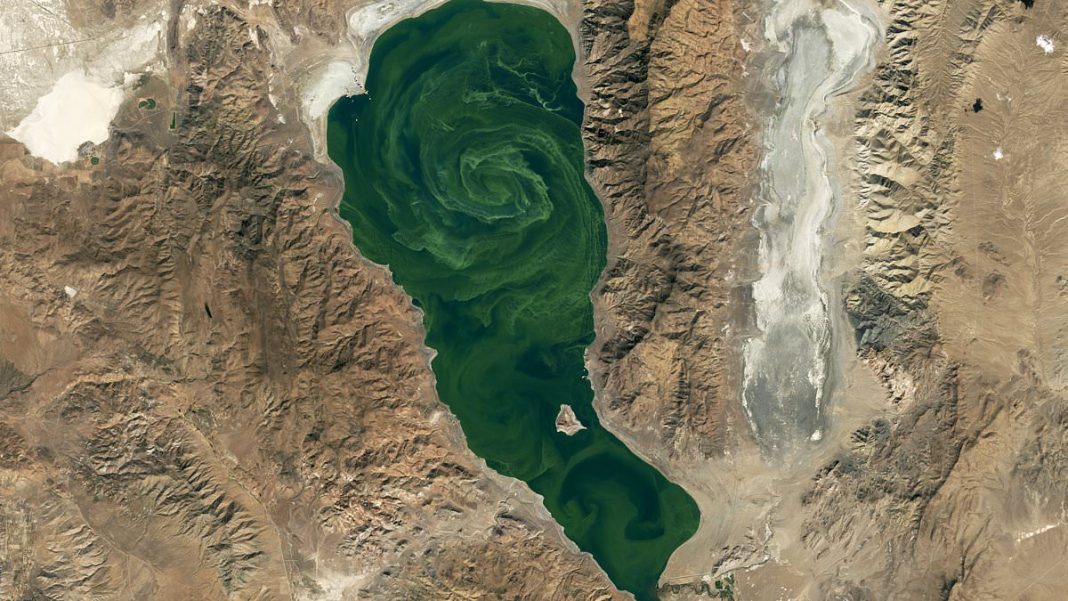Nevada lake develops mesmerizing green swirls visible from space,
Pyramid Lake in northeast Nevada developed intense eerie green swirls that could be seen from space.
The 125,000-acre Pyramid Lake develops an algal bloom almost yearly, but 2024 has turned into ‘one of the most active bloom events seen in years.’
Images of the lake were taken by NASA’s Landsat 9 satellite and the Paiute Tribe identified that the main reason for this year’s spooky coloring was higher than normal levels of Nodularia spumigena.
This is a type of cyanobacteria – also known as blue-green algae – that’s commonly found in warm, brackish bodies of water and has been responsible for the water’s green hues every year.
Although it may look pretty, the algae can release dangerous toxins like microcystin that irritate the skin and cause kidney and liver damage if they’re ingested.
The Pyramid Lake Paiute Tribe monitors the lake’s algae levels and is now warning the public that they should avoid coming into contact with the water at all costs.
‘We always want to make sure to make people aware of that, so that they would either not bring their animals out or they would restrict them and have their own safe drinking water,’ Aaron Bill, water quality program manager with the tribe’s natural resources department told the San Francisco Chronicle.
‘The bloom material is breaking down and is releasing the toxin microcystin into the water, which signals the turn towards normal conditions that may take 2-3 weeks to normalize,’ the tribe said.
Pyramid Lake is located roughly 35 miles northeast of Reno, Nevada and attracts a wide array of fish and birds, making it a popular location for wildlife enthusiasts.
It is also one of the last remnants of an ancient water body called Lake Lahontan, which existed up until the last ice age and is the only remaining habitat for the endangered cui-ui fish.
The lake’s shallow and tepid waters also make it an ideal breeding spot for algal blooms.
‘It looks like split pea soup, where it’s that army-green color,’ Bill told the SF Chronicle.
And although the lake routinely experiences the cyanobacteria bloom every summer or fall, storms that developed in mid-October this year ‘led to a lot of wave action, and that did a good job of breaking up the material, getting it to settle down to the lake bottom,’ Bill said.
A water quality analysis conducted by the San Francisco Estuary Institute revealed that chlorophyll-a and cyanobacteria had increased between late September and mid-October, with the colors peaking around October 15.
Algae has an important role of keeping lakes fertile and healthy by preventing the sun’s rays from reaching the lakebed which in turn, reduces the water weeds that would block out the oxygen, effectively choking the lake.
However, the blooms are highly toxic and have been responsible for visitors falling ill with skin rashes, diarrhea and fatigue.
When the microcystin is inhaled, it breaks open in the stomach and can cause serious health problems – from rashes and diarrhea to vomiting, respiratory problems, liver damage and neurological effects.
The toxin can also lead to neurological problems when it crosses the blood-brain barrier and enters the brain.
Nodularia spumigene also has the potential to produce toxins like nodularin which primarily targets the liver and can cause cytoskeletal damage and necrosis which can lead to hemorrhaging and death if consumed at high levels.
There isn’t a definitive date for when algal blooms first started appearing in Pyramid Lake, but historical records show that they have been occurring for a long time.









